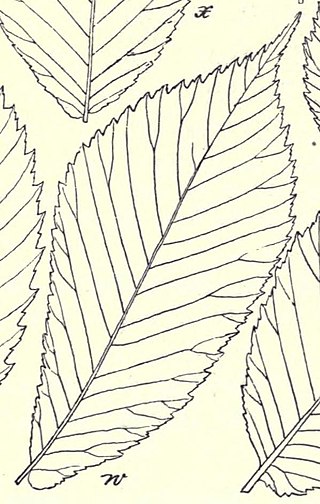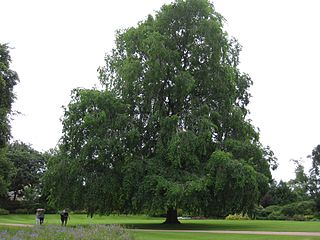Related Research Articles
The hybrid elm cultivar Ulmus × hollandica 'Wredei', also known as Ulmus × hollandica 'Dampieri Aurea' and sometimes marketed as Golden Elm, originated as a sport of the cultivar 'Dampieri' at the Alt-Geltow Arboretum, near Potsdam, Germany, in 1875.

Ulmus 'Exoniensis', the Exeter elm, was discovered near Exeter, England, in 1826, and propagated by the Ford & Please nursery in that city. Traditionally believed to be a cultivar of the Wych Elm U. glabra, its fastigiate shape when young, upward-curving tracery, small samarae and leaves, late leaf-flush and late leaf-fall, taken with its south-west England provenance, suggest a link with the Cornish Elm, which shares these characteristics.
The Field Elm cultivar Ulmus minor 'Viminalis Marginata', a variegated form of Ulmus minor 'Viminalis', was first listed as Ulmus campestris var. viminalis marginataHort. by Kirchner in 1864. Both Van Houtte and Späth marketed an U. campestris viminalis marginata in the late 19th century.
The American Elm cultivar Ulmus americana 'Nigricans'Dieck was cloned from a selection made from seedlings raised by the Zöschener Baumschule, Zöschen, Germany, and listed by Georg Dieck with a brief description in Haupt-catalog der Obst- und gehölzbaumschulen des ritterguts Zöschen bei Merseburg, 1885.
The elm cultivar Ulmus 'Crispa Aurea' was first mentioned by Schelle & Beissner in 1903, as Ulmus montana crispa aurea.
The Wych Elm cultivar Ulmus glabra 'Latifolia Aurea' was listed by Schelle in Beissner et al, Handbuch der Laubholz-Benennung (1903), as Ulmus glabraMillerlatifolia aurea, but without description. In the Netherlands in the late 19th and early 20th centuries, however, Ulmus montana latifolia aurea was a synonym of the wych cultivar 'Lutescens', and Green reclassified Schelle's 'Latifolia aurea' as a form of U. glabraHudson.

The putative Wych Elm cultivar Ulmus glabra 'Macrophylla' [literally 'long-leaved', though also 'large-leaved'] was first mentioned by Lavallée in 1877 as U. montana var. macrophylla (fastigiata). The Späth nursery of Berlin marketed an U. montana macrophylla in the late 19th and early 20th century; both Späth and the Hesse Nursery of Weener, Germany, supplied it in the 1930s. At that time, Ulmus montana was used both for wych elm cultivars and for hybrid cultivars of the Ulmus × hollandica group.
The European White Elm cultivar Ulmus laevis 'Aureovariegata', a yellow-variegated form, may have been the tree first listed, without description, in Hortus Regius Monacensis (1829) as Ulmus effusa variegata, grown at the Munich Botanic Garden. An Ulmus effusa fol. variegatis (Hort.) was first described c.1890 by the Späth nursery of Berlin, which distributed the tree in the late 19th century. The name U. effusa f. aureovariegata appeared in Beissner and Schelle's Handbuch der Laubholz-Benennung, 1903, without description.
The European White Elm cultivar Ulmus laevis 'Colorans' was listed as U. effusa var. colorans by Kirchner in Petzold & Kirchner, Arboretum Muscaviense (1864).

Ulmus × hollandica 'Klemmer', or Flanders Elm, is probably one of a number of hybrids arising from the crossing of Wych Elm with a variety of Field Elm, making it a variety of Ulmus × hollandica. Originating in the Bruges area, it was described by Gillekens in 1891 as l'orme champêtre des Flandres in a paper which noted its local name, klemmer, and its rapid growth in an 1878–91 trial. Kew, Henry (1913), and Krüssmann (1976) listed it as an Ulmus × hollandica cultivar, though Henry noted its "similarity in some respects" to field elm Ulmus minor, while Green went as far as to regard it as "possibly U. carpinifolia" (:minor).
The Field Elm cultivar Ulmus minor 'Picturata' was listed in the 1880 catalogue of Simon-Louis, as Ulmus picturataCripps, suggesting an English origin in the nursery of Thomas Cripps of Tunbridge Wells, Kent, who marketed elm cultivars in the 1860s. Clibrans' nursery of Altrincham, Cheshire, marketed it in the early 20th century as Ulmus campestris picturata variegata, their Ulmus campestris being English Elm. Elwes and Henry (1913) placed it under English Elm cultivars.

The Field Elm cultivar Ulmus minor 'Viminalis Pulverulenta' (:'powdery'), also known as 'Viminalis Variegata', a variegated form of U. minor 'Viminalis', was first mentioned by Dieck, in 1885 as U. scabra viminalis pulverulentaHort., but without description. Nursery, arboretum, and herbarium specimens confirm that this cultivar was sometimes regarded as synonymous with U. minor 'Viminalis Marginata', first listed in 1864, which is variegated mostly on the leaf margin. It is likely, however, that 'Pulverulenta' was the U. 'Viminalis Variegata', Variegated Twiggy-branched elm, that was listed and described by John Frederick Wood, F.H.S., in The Midland Florist and Suburban Horticulturist 1847 and 1851, pre-dating both Kirchner and Dieck. Wood did not specify the nature of the variegation.
The elm cultivar Ulmus 'Nemoralis' was listed by Schelle in Beissner et al. (1903), as U. campestris f. nemoralisHort. Considered "possibly U. carpinifolia " by Green.
The European White Elm cultivar Ulmus laevis 'Urticifolia' known as the Nettle Leaved Elm was raised by Jacques as a chance seedling in 1830, and propagated by grafting. It was later mentioned by de Vries in 1906.

Ulmus × hollandica 'Wentworthii Pendula', commonly known as the Wentworth Elm or Wentworth Weeping Elm, is a cultivar with a distinctive weeping habit that appears to have been introduced to cultivation towards the end of the 19th century. The tree is not mentioned in either Elwes and Henry's or Bean's classic works on British trees. The earliest known references are Dutch and German, the first by de Vos in Handboek tot de praktische kennis der voornaamste boomen (1890). At about the same time, the tree was offered for sale by the Späth nursery of Berlin as Ulmus Wentworthi pendulaHort.. The 'Hort.' in Späth's 1890 catalogue, without his customary label "new", confirms that the tree was by then in nurseries as a horticultural elm. De Vos, writing in 1889, states that the Supplement to Volume 1 includes entries announced since the main volume in 1887, putting the date of introduction between 1887 and 1889.
The Field Elm cultivar Ulmus minor 'Cucullata Variegata', a variegated form of U. minor 'Cucullata', was listed by C. de Vos, in 1867, as U. americana cucullata folia variegata and by Schelle in Beissner Handbuch der Laubholz-Benennung, 82 (1903) as U. campestris concavifolia cucullata variegataHort, without description.

The field elm cultivar Ulmus minor 'Viminalis' (:'willow-like'), occasionally referred to as the twiggy field elm, was raised by Masters in 1817, and listed in 1831 as U. campestris viminalis, without description. Loudon added a general description in 1838, and the Cambridge University Herbarium acquired a leaf specimen of the tree in 1866. Moss, writing in 1912, said that the Ulmus campestris viminalis from Cambridge University Herbarium was the only elm he thought agreed with the original Plot's elm as illustrated by Dr. Plot in 1677 from specimens growing in an avenue and coppice at Hanwell near Banbury. Elwes and Henry (1913) also considered Loudon's Ulmus campestris viminalis to be Dr Plot's elm. Its 19th-century name, U. campestris var. viminalis, led the cultivar to be classified for a time as a variety of English Elm. On the Continent, 'Viminalis' was the Ulmus antarcticaHort., 'zierliche Ulme' [:'dainty elm'] of Kirchner's Arboretum Muscaviense (1864).

The Field Elm cultivar Ulmus minor 'Monumentalis', the tomb elm (Grabmal-Rüster), was raised as a sucker of U. suberosa by Sebastian Rinz, the city gardener of Frankfurt, before 1855 and listed by the Jacob-Makoy nursery of Liège in their 1861 catalogue as Ulmus monumentalisRinz, "a new variety". Kirchner (1864) described it, confirming that it had only recently been propagated by Rinz and established in the nursery. It was distributed from the 1880s by the Baudriller nursery, Angers, and by the Späth nursery, Berlin, as U. campestris monumentalisRinz., appearing separately in their catalogues from U. minor 'Sarniensis', the Guernsey or Wheatley Elm, with which, according to Henry, it was confused on the continent. Krüssmann, for example, gives 'Monumentalis' as a synonym of 'Sarniensis'. 'Sarniensis' is known as monumentaaliep [:monumental elm] in The Netherlands. Springer noted that the Dutch monumentaaliep was "not the actual monumentaaliep but U. glabraMill.var. Wheatleyi Sim. Louis", and that it "should be renamed U. glabraMill. var. monumentalisHort.(non Rinz)". In England, Smith's of Worcester listed Ulmus monumentalis separately from Ulmus 'Wheatley' in the 1880s.
The field elm cultivar 'Punctata' ['spotted', the leaf] first appeared in the 1886–87 catalogue of Simon-Louis of Metz, France, as U. campestris punctata. It was distributed by the Späth nursery, Berlin, in the 1890s and early 1900s as U. campestris punctataSim.-Louis, the Späth catalogue listing it separately from U. campestris fol. argenteo-variegata and from U. campestris fol. argenteo-marginata. Green considered it possibly a synonym of the Field Elm cultivar 'Argenteo-Variegata'.

The Wych Elm cultivar Ulmus glabra 'Concavaefolia', a form with up-curling leaves, was listed in Beissner's Handbuch der Laubholz-Benennung (1903) as Ulmus montana cucullataHort. [:'hooded', the leaf], a synonym of the Ulmus scabraMill. [:glabraHuds.] var. concavaefolia of herbarium specimens. An Ulmus campestris cucullata, of uncertain species, had appeared in Loddiges' 1823 list, but Loudon's brief description (1838) of concave- and hooded-leaved elms was insufficient for later botanists to distinguish them. The earliest unambiguous description appears to be that of Petzold and Kirchner in Arboretum Muscaviense (1864).
References
- ↑ Catalog der dritten temporären Ausstellung des Gartenbaues. Vol. 3. Vienna. 1873. p. 26.
{{cite book}}: CS1 maint: location missing publisher (link) - 1 2 Jäger, Hermann; Beissner, Ludwig (1889). Die ziergehölze der gärten und parkanlagen. B.F. Voigt. p. 402.
- ↑ Beissner, L; Schelle, E; Zabel, H (1903). Handbuch der Laubholz-Benennung. Deutsche Gartenbaubibliothek e.V. p. 87.
- ↑ Green, Peter Shaw (1964). "Registration of cultivar names in Ulmus". Arnoldia. Arnold Arboretum, Harvard University. 24 (6–8): 41–80. Retrieved 16 February 2017.
- ↑ Elwes, Henry John; Henry, Augustine (1913). The Trees of Great Britain & Ireland. Vol. 7. p. 1852.
- ↑ Schneider, Camillo Karl (1904). Illustriertes Handbuch der Laubholzkunde. Vol. 1. Jena G. Fischer. p. 213.